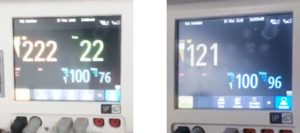When Kimberly Mays was about 20 weeks pregnant with her second child, she began to feel faint and overheated. An ultrasound revealed that Mays’ baby had a very rapid heart rate, and she was referred to a maternal-fetal specialist near her hometown of Southern Pines, North Carolina.
 There, she learned her baby’s heart rate was 270—a normal heart rate for a baby in the womb is between 120 and 160. The specialist told her to immediately go see the maternal-fetal medicine specialists at UNC Health.
There, she learned her baby’s heart rate was 270—a normal heart rate for a baby in the womb is between 120 and 160. The specialist told her to immediately go see the maternal-fetal medicine specialists at UNC Health.
Mays’ baby had a condition called supraventricular tachycardia (SVT). A relatively common heart condition in adults and children, SVT is an irregularly fast or erratic heartbeat (arrhythmia) that affects the heart’s upper chambers.
Helping Baby’s Heart in Utero
Fetal SVT, which occurs while a baby is still in the womb, is rare and if persistent, can be life-threatening to the baby and require treatment.
Mays’ medical team at UNC Health, which included pediatric cardiology, pediatric pharmacy and maternal-fetal medicine specialists, hoped that would be the case for her baby.
“We went up there, and they put me on a heart medication and monitored me,” Mays says. “I was there for two weeks and nothing changed.”
 Usually, giving heart medication to the mom will correct the baby’s heart rate and allow it to continue to grow and avoid preterm birth.
Usually, giving heart medication to the mom will correct the baby’s heart rate and allow it to continue to grow and avoid preterm birth.
“Treatment for fetal SVT is usually to give the mom medications that cross the placenta and treat the fetus,” says UNC Health maternal-fetal medicine doctor William Goodnight, MD. “Rarely, though, that is not enough to help the baby’s heart rate.”
In addition, Mays’ baby started to develop hydrops fetalis, a condition in which large amounts of fluid build up in tissues and organs, causing extensive swelling. There are various causes of hydrops, including an abnormal heart rhythm that impairs heart function, which is what led to hydrops for Mays’ baby.
If hydrops is left untreated, it can be life-threatening. Up to half of the babies born with hydrops due to abnormal heart rhythm do not survive, Dr. Goodnight says, and because Mays’ baby was very premature, delivery was not a good option either.
Since the baby was not responding to the medicine Mays was taking, her medical team needed to do something else to lower the baby’s heart rate and to remove the dangerous excess fluid.
Mays’ care team decided to deliver the heart medication directly to the baby while also removing the excess fluid.
“Because of the hydrops and heart failure, the baby did not receive enough medication through mom. We thus performed a direct injection of the heart medication into the baby’s abdomen using a thin needle inserted into the uterus guided by an ultrasound,” Dr. Goodnight says. “This allowed the baby to absorb the medication more effectively.”
They did the first injection when Mays was 22 weeks along. Several procedures (the direct injection to the baby through the uterus) were needed until she was 28 weeks, when the baby’s heart rate returned to a normal range permanently.
“We had to do it several times to get the dose high enough in the fetus to correct the SVT,” Dr. Goodnight says.
Mays continued to take oral heart medicine and was monitored three times a week by a specialist near home, and the hydrops completely resolved.
“They wanted to keep me there in the hospital, but I was ready to come home to my 5-year-old son,” Mays says. “Being there without him was very, very hard. Not being able to hold him was the worst part.”
A Sweet, Stubborn Toddler

The baby’s heart rate continued to stay at a normal rate throughout the rest of Mays’ pregnancy, and when Mays was 37 weeks, she returned to Chapel Hill to deliver Eliza.
“Everything was fine. Her heart rate was normal, and she came out stronger than ever,” Mays says. “I’ve never seen a baby so strong.”
Although there is a small chance of recurrence of SVT after a diagnosis of fetal SVT, if it does not recur in the first year, the long-term risk is low, Dr. Goodnight says.
Eliza recently celebrated her first birthday. Mays describes her as a bright, stubborn toddler who loves giving hugs and eating strawberries.
“When she wants something, if she doesn’t have it, she throws her little tantrums. She was doing toddler stuff at 10 months,” Mays says. “The doctor said that she was learning really, really fast. There is no sign that she went through any of that. She’s so amazing.”
Have questions about high-risk pregnancy? Talk to your doctor or contact UNC Maternal-Fetal Medicine at (984) 974-2131.

